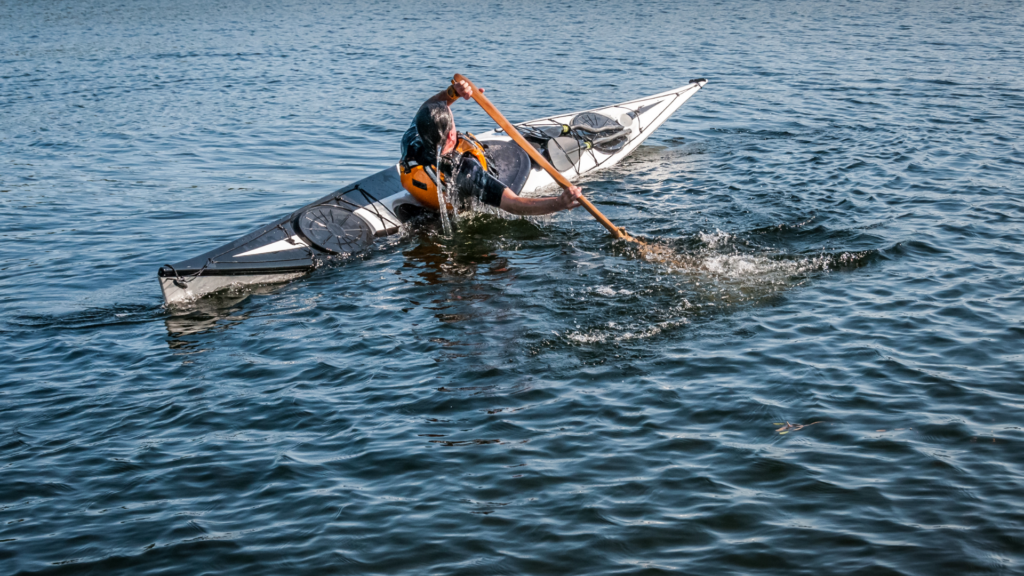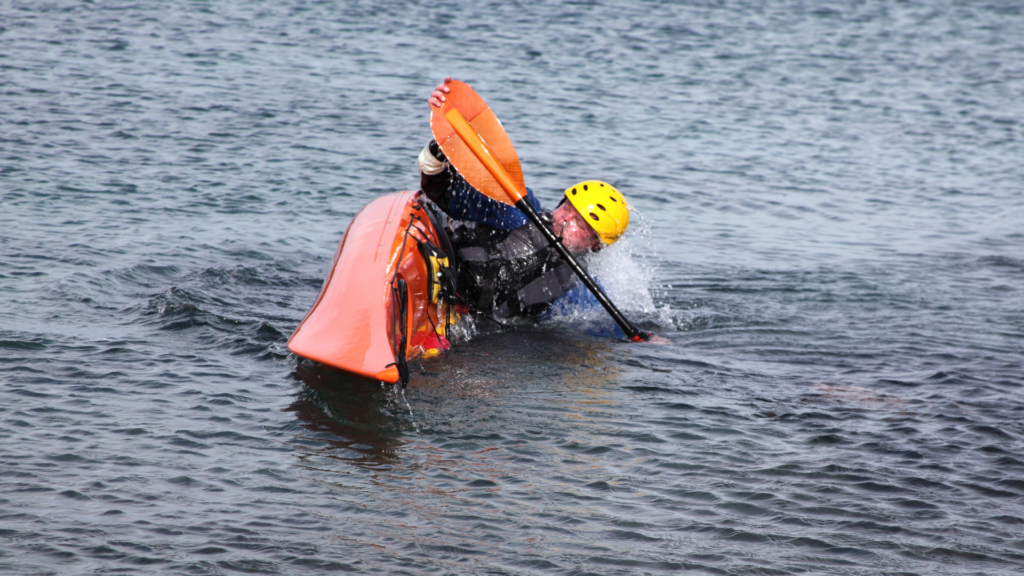Kayaking is a thrilling and adventurous water activity, and learning to roll a kayak is an essential skill for kayakers of all levels. Rolling a kayak can be challenging for beginners, but with practice and guidance, anyone can master it.
In this article, we’ll discuss the step-by-step process of how to roll a kayak and offer some tips and tricks to help you improve your technique.
Why Learn How to Roll a Kayak?

Learning the way to roll a kayak is a critical ability for any kayaker, specifically for individuals who need to embark on whitewater kayaking. Rolling a kayak brings it back to its upright function after it has flipped over, permitting you to keep paddling without having to go out of the kayak and turn it over.
This shop time is not the best; however, it additionally saves you panic and keeps you secure in tough situations. In this article, we will guide you through the stairs to grasp the artwork of rolling a kayak.
Essential Gear for Rolling a Kayak

Before learning how kayakis roll, it’s important to have the right equipment. This includes a well-fitting kayak, paddle, and splash skirt. You’ll also need a helmet and a personal flotation device (PFD) to stay safe. It is important to have the right equipment to ensure the comfort and safety of practicing kayaking.
Step-by-Step Guide to Rolling a Kayak

To roll a kayak, you have to follow a step-by-step process that involves several movements. This involves positioning the body, using the paddle and hip flags, and then returning to a stable upright position. We’ll walk you through each step in detail and give you tips and tricks to help you perfect your technique.
Kayaking can be intimidating for beginners, but with proper instruction and practice, it can become a valuable skill. Here’s a step-by-step guide to rolling a kayak:
- Setup: Start with the aid of locating a peaceful and shallow frame of water. Put on all important protection equipment which includes a lifestyle jacket, helmet, and nostril plugs.
- Setup Position: Get into the setup role with the aid of leaning ahead and placing your arms at the paddle shaft, one hand above the cockpit and one below. Your elbows have to be out, and your paddle has to be perpendicular to the kayak.
- Submerge the Kayak: Tilt your head to at least one aspect and submerge the kayak so that the water stage is above your head. As you tilt your head, sweep your paddle blade far from your kayak inside the course of the roll.
- Hip Snap: Once the kayak is upside down, use a hip snap to convey the kayak returned up. Push together along with your legs and hips at the same time as concurrently pulling at the paddle to create leverage and produce the kayak returning as much as the surface.
- Recover: Once the kayak is right, take a deep breath and get your paddle better with the aid of bringing it returned to the setup role.
- Repeat: Practice this method on each facet of the kayak till you experience comfort and are assured of your capacity to roll the kayak.
Remember that mastering the roll takes time and practice, so don’t get discouraged if it takes several attempts to get it right.
Common mistakes to avoid when rolling a kayak

Even experienced paddlers make mistakes when rolling their kayaks. Some of the most common mistakes include placing the hands incorrectly on the oar, not snapping the hips in enough, and failing to keep the oar close to the body. We help you identify and avoid these mistakes so you can improve your technique and roll your kayak with ease.
Tips for improving your kayak rolling technique

Perfecting your kayak rolling technique takes practice, patience, and persistence. We will give you tips to improve your technique, such as practicing in the pool, practicing hip-hop, and focusing on your breathing. We also provide advice on developing self-confidence and maintaining a positive attitude.
Perfecting your kayak rolling technique takes practice, patience and persistence. Here are some tips to help you master the skills:
- Relax: Keep your body relaxed and calm. Tension can make the kayak harder to roll and cause too much energy to be expended.
- Practice the basics: Make sure you’ve mastered the basic steps of rolling a kayak, including setting up, sweeping, and hip-pulling. Improve your posture. Your head, shoulders, and hips should be aligned and facing the surface of the water. This position gives you the boost you need to roll the kayak.
- Use your core: Use your core to turn your body and initiate a hip snap.
- Don’t rush; take your time with each step of the roll. Rushing can lead to mistakes and make a successful roll difficult. Practice from both sides. It is important to be able to turn your kayak from both sides. This will make you a more versatile and confident paddler.
- Ask for feedback: Ask for feedback from experienced paddlers or take a course with a certified instructor. They can offer valuable tips and corrections to help you improve your technique.
By incorporating these tips into your training routine, you can improve your kayak rolling technique and become a more confident and skilled kayaker.
Practice and master your kayak launch skills
The key to mastering kayak rolling skills is practice. We provide advice for safe and effective training, including finding a suitable location, training with a partner, and gradually building confidence. With practice, you can roll your kayak with ease and confidence, making your paddling experience safer and more enjoyable.
Practicing and mastering kayak rolling skills takes time, dedication, and patience. Here are some tips to help you improve.
- Start in still water. It is best to practice your kayak rolling skills in still water to minimize distractions and potential hazards. You can gradually move on to rougher waters as you gain confidence in your abilities.
- Focus on technique: When practicing, focus on your technique, not the result. It is important to develop good habits and muscle memory before attempting the perfect throw.
- Use a partner: Having a partner can be helpful, especially if you’re just starting out. They can provide feedback and support as you practice your roll.
- Practice with different kayaks: Every kayak handles differently, so it’s important to practice rolling with different types of kayaks to improve your technique and adaptability.
- Set goals and track progress: Set realistic goals and track your progress over time. Celebrate small victories and use failures as learning opportunities to improve.
- Get professional instruction: If you’re having trouble mastering the skills of rolling your kayak, consider taking a class or getting professional instruction. A qualified instructor can provide personal feedback and help you identify areas for improvement.
how do you roll a kayak without a paddle?
It is not recommended to attempt to roll a kayak without a paddle, as a paddle is an essential aid to rolling. However, in some cases, the paddler may lose the paddle and have to use other techniques when casting. Here are the steps to roll a kayak without a paddle:
- Pull and lean: As soon as you realize you have lost your paddle, push your body down and lean toward the surface of the water. This helps keep your head and shoulders closer to the surface of the water, making it easier to stay steady.
- Arm Swing: Sweep both arms to the side and then back to the surface of the water. This motion helps create the horizontal force that turns your kayak.
- Use your hips. Sweep your arms and use your hips to propel the kayak forward and then toward the surface of the water.
- Tuck and roll: As you surface the kayak, press your head and shoulders toward your chest, then roll your body toward the surface of the water. Use your momentum to finish the roll. Remember that rolling a kayak without a paddle is much more difficult than rolling with a paddle and should only be attempted by experienced paddlers.
how to roll kayaks for beginners
Beginners who want to learn to kayak are advised to take lessons with a certified paddling instructor or join a kayak club where experienced paddlers can provide guidance and support. Practicing in calm, shallow water and slowly working up to more challenging conditions can also help improve your reeling technique over time.
FAQ’s
Can you teach yourself to roll a kayak?
It is possible to teach yourself to roll a kayak, but it is recommended to seek professional instruction and practice in a safe environment.
How hard is rolling a kayak?
Rolling a kayak can be challenging for beginners, but with practice and proper technique, it can become easier and more efficient.
How long does it take to learn to roll a kayak?
The amount of time it takes to learn to roll a kayak varies depending on the individual’s skill level, frequency of practice, and the quality of instruction. It can take anywhere from a few days to several months to master the technique.
Do I need to learn to roll a kayak?
While it is not a mandatory skill for kayaking, learning to roll a kayak can greatly improve your safety and enjoyment on the water, especially when kayaking in rough conditions.
How do you teach someone to roll a kayak?
Teaching someone to roll a kayak requires patience, clear instruction, and a safe learning environment. It is recommended to seek professional instruction or guidance from experienced kayakers.
Can you roll a kayak without a skirt?
It is possible to roll a kayak without a skirt, but it is not recommended as it increases the risk of water entering the kayak and making it difficult to roll back up. A skirt helps to keep the water out and allows for a more efficient rolling technique.
Conclusion
Rolling a kayak is an important skill that every kayaker should learn to improve their safety and performance on the water. It can be challenging for beginners, but with patience, practice, and proper guidance, anyone can master the technique.
Remember to always wear appropriate gear, start with the basics, and never be afraid to ask for help or guidance from experienced kayakers. With time and effort, you’ll be rolling your kayak with ease and confidence.

